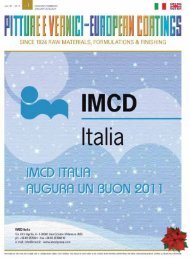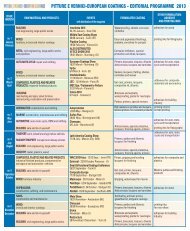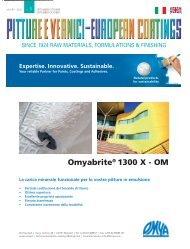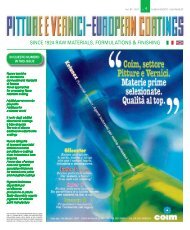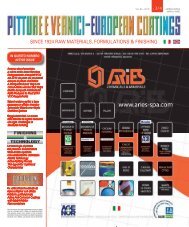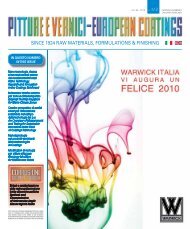since 1924 raw materials, formulations & finishing - PITTURE E ...
since 1924 raw materials, formulations & finishing - PITTURE E ...
since 1924 raw materials, formulations & finishing - PITTURE E ...
You also want an ePaper? Increase the reach of your titles
YUMPU automatically turns print PDFs into web optimized ePapers that Google loves.
distribuzione esercitano il loro impatto<br />
sul potenziale di brillantezza della pittura.<br />
Una media granulometrica bassa<br />
dà una brillantezza superiore, ma ne risente<br />
la diffusione se la media è inferiore<br />
al valore ottimale (.25 micron). Una<br />
distribuzione maggiore, risultante da<br />
una morfologia del pigmento più carente,<br />
una macinazione inferiore oppure<br />
una dispersione inadeguata riducono<br />
la brillantezza potenziale della pittura<br />
finale. In fig. 8 è presentato il rapporto<br />
fra brillantezza e granulometria.<br />
Grado di dispersione<br />
I produttori di pigmenti dispongono di<br />
varie tecniche di macinazione. Un test<br />
semplice consiste nell’inserire il TiO2in<br />
Frazione volume (%) / Volume Fraction (%)<br />
una resina alchidica in condizioni di<br />
basse forze di taglio per poi condurre<br />
l’analisi Hegman. È disponibile al presente<br />
un software per fotografie digitali<br />
che consente di eseguire un’analisi<br />
più accurata della lettura Hegman.<br />
Fig. 9 presenta l’immagine digitale di<br />
un rivestimento su scala Hegman.<br />
Se si analizzano i pigmenti disponibili<br />
in commercio (fig. 10) risulta evidente<br />
che esistono varie tecniche a disposizione<br />
dei produttori di TiO2 per quanto<br />
concerne la loro attività di macinazione.<br />
L’esperienza ha dimostrato che un<br />
dispersore ad alta velocità può essere<br />
utile per realizzare rivestimenti di alta<br />
qualità se il numero delle particelle diffuse<br />
è inferiore a 30. Al di sopra di 30<br />
particelle diffuse, è necessario utilizzare<br />
un veicolo di macinazione e/o si<br />
Fig. 7 Rapporto distribuzione granulometrica/proprietà della pittura<br />
Particle size distribution relationship to paint properties<br />
Brillantezza dell’emulsione / Emulsion Gloss<br />
Ben dispersi<br />
Well Dispersed<br />
Proprietà ottiche<br />
Potere coprente<br />
potere colorante, sottotono<br />
Optical Properties<br />
Hiding Power, Tint Strength<br />
Undertone<br />
Diametro-micron / Diameter - microns<br />
Proprietà del film<br />
Brillantezza, DOI<br />
Film Properties<br />
Gloss, DOI<br />
Scarsamente disperso<br />
Poorly Dispersed<br />
Grado di dispersione<br />
Degree of Dispersion<br />
Finezza Hegman / Hegman Fineness<br />
Brillantezza dell’emulsione e correlazione PSD / Emulsion Gloss and PSD Correlation<br />
PSD % > 0.5 micron<br />
Fig. 8 Rapporto fra la brillantezza dell’emulsione e la granulometria<br />
Relationship between emulsion gloss and particle size<br />
MATERIE PRIME - PIGMENTI<br />
Fig. 10 Schema del valore individuale di diffusione<br />
Individual value plot of scats<br />
The K value for pigments is a function of the<br />
pigment color as measured by L* (see Figure<br />
4). As described earlier in this article, pigment<br />
color is a function of the process from<br />
which it is made. Figure 5 shows the color<br />
performance of a large sample set of commercially<br />
available pigments. As a general<br />
rule, chloride pigments possess a higher<br />
whiteness level as measured by L* and are<br />
less yellow as measured by b*. So, knowing<br />
the color of the pigment, the absorption<br />
coefficient can be calculated.<br />
The scattering coefficient for TiO 2 pigments<br />
is a function of the crystal refractive index,<br />
the purity of the pigment, and the particle<br />
morphology of the underlying TiO 2 [2].<br />
For almost all coatings applications, the<br />
rutile form of TiO 2 is used. Therefore, the<br />
crystal refractive index is the same. The<br />
purity of the TiO 2 is the actual TiO 2 content<br />
of the pigment which varies because of<br />
surface oxide dilution.<br />
The underlying particle morphology is<br />
determined by the particle size distribution<br />
of the pigment.<br />
Hiding power and tint strength<br />
An optical density [3,4] test has been developed.<br />
By measuring the transmitted light of<br />
TiO 2 in a water solution at very low concentration<br />
(20 ppm), it is possible to determine<br />
the hiding power potential of a TiO 2 grade.<br />
Optical Density = Hiding Power = S + K<br />
S = Scattering Coefficient<br />
K = Absorption Coefficient<br />
Since K has been determined by pigment<br />
color, we can calculate S with the following<br />
equation:<br />
S = Hiding Power - K<br />
Knowing S and K, we can now calculate<br />
12 Pitture e Vernici - European Coatings • 7-8 / 2010<br />
▼<br />
▼<br />
Diffusione / Scats<br />
Finezza / Fineness<br />
Lettura Hegman<br />
Hegman Reading<br />
RAW MATERIALS - PIGMENTS<br />
Fig. 9<br />
Immagine<br />
digitale<br />
di un<br />
coating<br />
su scala<br />
Hegman<br />
Digital<br />
output<br />
of a<br />
coating<br />
on a<br />
Hegman<br />
scale




